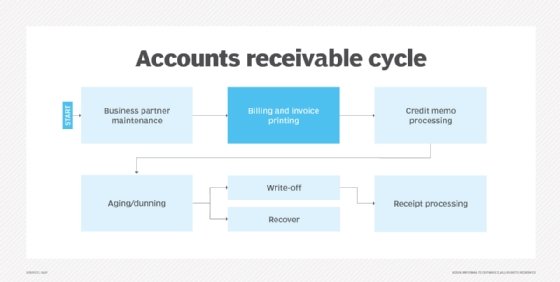What is days sales outstanding (DSO)?
Days sales outstanding (DSO) measures the average time it takes a business to collect payments after a sale. Specifically, DSO calculates the average length of time needed for a company to collect its accounts receivable (AR).
It is one of the primary metrics in a company's cash conversion cycle, alongside days inventory outstanding, which is the average number of days it takes for inventory to be sold, and days payable outstanding, which is the average number of days it takes to pay bills and invoices.
DSO is also known as days receivables, average collection period or days' sales in receivables.
Analyzing DSO provides insights into a 'company's liquidity and cash flow. A lower DSO indicates quick collection, while a higher DSO suggests slower collections, which could impact cash flow and operational flexibility.

How to calculate days sales outstanding
DSO is typically calculated on a monthly, quarterly or annual basis. The formula is as follows:
(Accounts Receivable / Sales Revenue) X Number of days in period = DSO
It's important to note that DSO calculation only considers credit sales, excluding cash transactions. By tracking DSO over time, businesses can monitor trends in collections and adjust their credit and collection policies as needed.
Example calculation
Consider a hypothetical company with sales revenue of $700,000 and accounts receivable of $400,000 for May (31 days):
DSO = ($400,000 / $700,000) X 31 = 17.71
The result indicates that, on average, the company takes approximately 18 days to collect payments after a sale. The DSO calculation can also indicate the following:
- How many sales were made during the specific time period.
- The estimated amount of cash invested in receivables.
- How fast customers paid.
- How well the collection department is performing.
- Whether the company is preserving customer satisfaction.
- Whether credit is being granted to customers who don't deserve it.
An effective way for businesses to use the DSO calculation is to keep it tracked month by month on a trend line -- or a series of plotted data points indicating a certain pattern or direction. Using the DSO in this way can help companies see any changes in their business's ability to collect payments from customers. A seasonal business can use a variation of this analysis by tracking the same month's metric on a year-by-year rate.
Applications of days sales outstanding
In general, a high DSO suggests slower collections, which might indicate potential liquidity issues, while a low DSO reflects a more favorable cash flow and efficient credit management.
To lower the DSO, a company must first determine what factors affect the sales and collection rates. Potential causes could be as follows:
- A company's sales team is offering longer payment terms in the hope that it will increase sales.
- Similarly, the company is encouraging customers to purchase with credit with the hope that this will generate the sale of more products and services.
- The company's collection department lacks efficiency and control.
- The customer has a preexisting negative credit standing.
While evaluating a specific DSO value can provide quick information about a company's cash flow, examining trends in the DSO over time can be more beneficial and impactful to a business's processes. A company might use an increasing DSO as an indication of a decline in customer satisfaction; longer terms of payment are being offered to boost sales; or customers with poor credit scores and history are being allowed to purchase on credit.
Furthermore, an increasing DSO will continue to impact a company's cash flow over time -- especially if the company relies on a consistent payment -- and might force the business to make large, costly changes.
Benchmarking days sales outstanding
Because DSO varies widely by industry, companies should benchmark their DSO against similar businesses within their sector. Factors influencing DSO benchmarks include business models, customer payment behaviors and seasonal trends. Generally, the benchmark is as follows:
- DSO under 45 days. Considered favorable for most industries, as it indicates faster collections.
- Higher DSO values. Common in industries that offer longer credit terms, like manufacturing and wholesale, but might indicate risk if cash flow is impacted.
To gain better insights, companies might track DSO trends monthly or annually and compare these metrics against industry peers.
Limitations of days sales outstanding
While DSO is a valuable metric, it should be used in context. Limitations include the following:
- Exclusion of cash sales. DSO only considers credit sales, so it might not fully represent a company's liquidity.
- Susceptibility to revenue fluctuations. Temporary revenue changes can affect DSO, so it should be analyzed alongside other metrics for accuracy.
- Seasonality effects. Seasonal businesses might experience fluctuations in DSO, making it harder to interpret short-term changes.
For an accurate view of accounts receivable efficiency, analysts should use DSO in conjunction with other metrics like days inventory outstanding and days payable outstanding.
Importance of DSO in financial analysis
DSO is an essential measure of liquidity and cash flow efficiency. Lower DSO values imply that the company can convert receivables into cash quickly, which is beneficial for sustaining operations and reinvesting in growth opportunities. Monitoring DSO also provides insights into the collection department's performance and identifies potential credit risks.
- Sales trends. DSO can help assess the volume of sales over time, particularly in credit-heavy sectors.
- Collection efficiency. A low DSO suggests efficient collections, whereas a high DSO might indicate inefficiencies in the collections department.
- Customer payment behavior. DSO reflects how promptly customers pay, which can impact cash flow stability.
- Credit risk management. Monitoring DSO helps identify whether credit is being extended to customers with potential credit issues, posing risks to the company's financial health.
Sometimes, a bill cannot be collected and a company would apply generally accepted accounting principles (GAAP) to cancel the bad debt. Also, key performance indicators are benchmarks that can help companies gauge success. Explore KPI templates for your executive dashboards. Furthermore, choosing the right KPIs and business metrics can be tricky. Learn which metrics businesses using public clouds should track and some tools to use.






